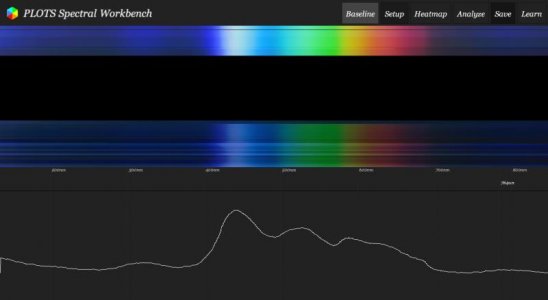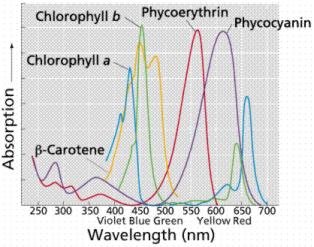The main goal of the configuration is to provide the best possible quality of light for coral photosynthesis. You do that; you can reduce the energy input. You can also put a little more energy to get a good aesthetic experience. There is also no direct link between a good quality light and the amount of zooxanthellae. Nutrient levels determine the amount - the quality of light determines how good the zooxanthellae, which are available at a given time, can utilize the light.
There are also two concepts one has to distinguish, reflective colours and colours originating from fluorescence (actually special cases of luminescence).
A reflective colour is a pigmentation, which certain wavelengths are absorbed, and some bounce back (reflects). White and black are special cases - white -> all visible wavelengths reflects, black -> all visible wavelengths are absorbed.
If we highlight a white (or a surface that reflects many wavelengths) with a largely monochromatic source (one or a few wavelengths) reflects these wavelengths for us as the colour of the monochromatic source.
If we highlight a black surface (or a surface that reflects few wavelengths) with the same source, we see no colour or we see it as very weak and grey.
All reflecting colours is between this two extremes but the corresponding wavelength (or wavelengths if it is a mixed colour)
must be in the source we use or a blending
Fluorescence is a totally different thing. It is more an active process than a passive reflective event. In short, it is a substance that captures a photon with a specific wavelength and sends out a photon of a different wavelength (wavelength - read energy quanta) Usually, the photon emitted again has a longer wavelength (lower energy quanta)
There are rare special cases where it is emitted a photon of lower wavelength (higher energy quanta) or an identical photon. If it occurs in corals I do not know but normal fluorescence is extremely common.
The photons in the blue area are those that occur most frequently in conjunction with fluorescence and corals. Around 420 nm is known to be extremely potent in this regard.
In a normal light (white light) are the colours we see with our corals a mix between the reflective colours and those from fluorescence. If we only use blue light so besides blue reflected light then just we see only colours from fluorescence. Is a coral red in the blue light, it is converted photons we see - the coral is a radiation source in itself!
@ mr.Wilson: with full respect: Your argument mixes wildly between reflective colours and colours we see due to fluorescence (and why does Google all the time spell colours like colors). I think that we must separate them in the discussion. I do not know any fluorescence based on red wavelengths (i.e. – red is the ingoing photons wavelength). It might be – do you have any links?
Your scientific links was helpful but after reading them – I’m more convinced than before that I’m on the right track.
However – the Israeli stuff point out something very important. If we get an optimal photosynthesis - a problem related to active oxygen radicals occurs. These wavelengths we use now can be so potent that we can cause bleaching of corals. The corals have weapons on this, they can develop anti-radicals, but it takes time. It requires a long habituation. There is reason to take it very gently at first with these wavelengths (420-460). Much more cautious compared with base the blue wavelengths at 460-475 nm.
If I look at the spectrum of the LED and LEP used in the article from Aquaculture. (Showing along the bottom of the page in the link), so I interpret it completely different from you. You have looked to the right of the blue peak at 470 nm in order to explain why the LEP was better in this trial. I am Swedish and look to the left of the peak and find my explanation there

@ tomservo
I still think that we should have asked for one of the white channels to use the red emphasis phosphor mix
You're probably right there
The spectrum of 60-watt hybrid chip looks to me almost like a full-spectrum chip. This means that 10 000 K will produce a lot of green. Too bad we did not know this from the beginning.
@ Kuya Cesar: I cannot see the images - you need to probably change the rights in Google
@ JACOXVII : Probably the 100 W chip
@ jt41time: Can you post a link to the driver?
@ ReefUrchin: I’ll coming back to you later on






